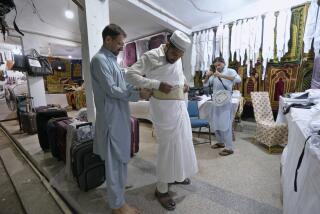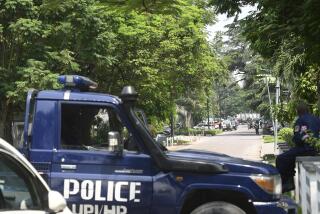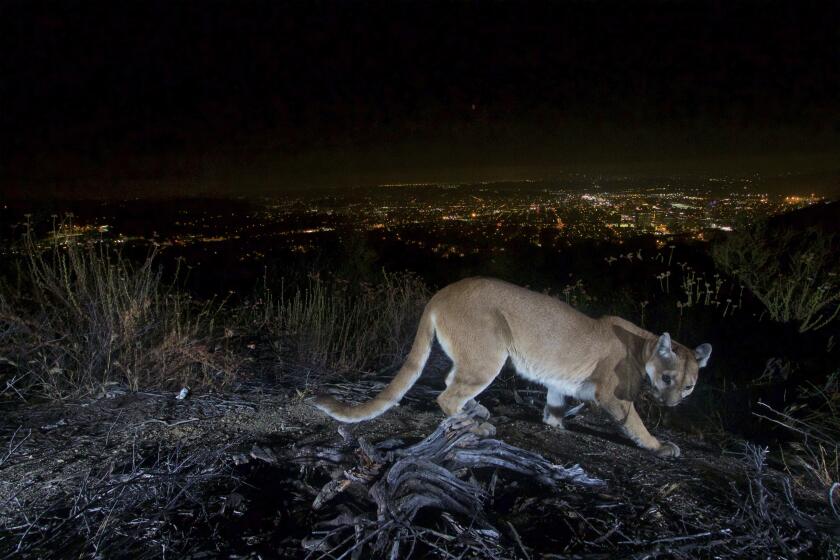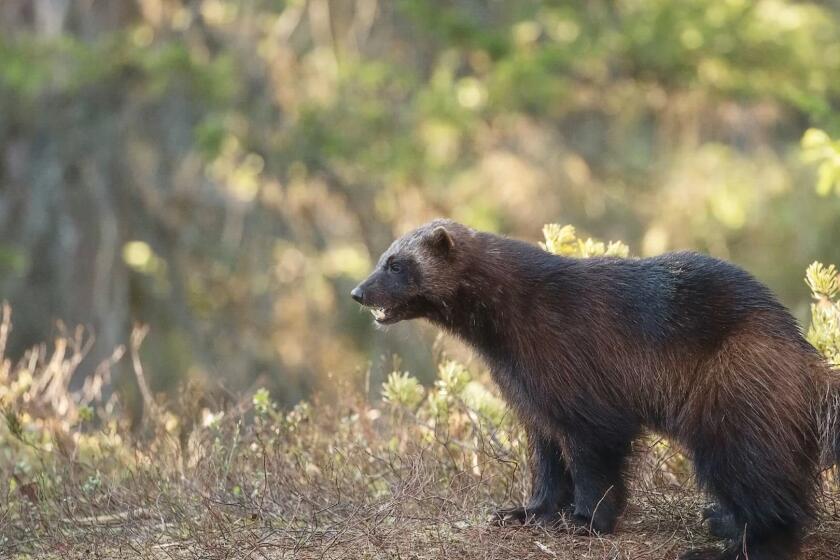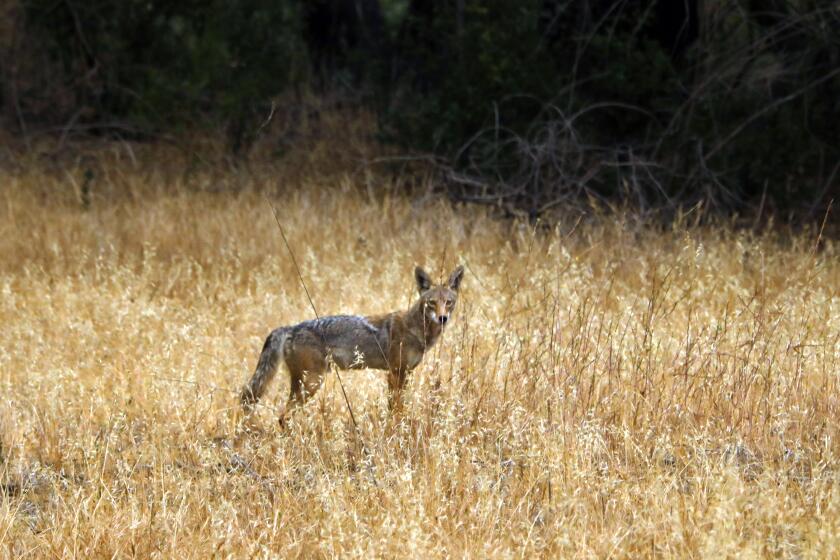A Poet of Cowboy Culture Rides to Ranch’s Rescue
They put him on a horse when he was 2, expecting he would accept his role in affluent St. Louis society. Instead, Drum Hadley rode southwest, notching his own place in a seamless border landscape.
Through his family-owned Animas Foundation, Hadley--poet, rancher, environmentalist--oversees the 500-square-mile Gray Ranch, covering more territory than the city of Los Angeles.
The Nature Conservancy has designated the ranch one of the world’s “last great places.” Environmental scientists say it’s even greater since Hadley’s foundation bought it three years ago.
The ranch in southwestern New Mexico’s Bootheel is in such good shape that it’s providing pastures for four drought-stricken nearby ranchers in a unique “grassbank” arrangement. Participating ranchers, in turn, agree never to subdivide their lands.
The Gray Ranch also has caught the attention of the natural foods industry, which hopes that grass-fed, hormone-free cattle will find markets among the health-conscious.
*
Hadley, 58, never studied agriculture. His environmental training came from an old rancher who showed him how the land had changed--the erosion, the encroachment of woody species on grasslands. He learned ranching, literally, from the ground up.
He can still rope with the vaqueros on the other side of his southern fence, the U.S.-Mexico frontier. He spent a couple of years as a young man learning his trade in Mexico after graduating from the University of Arizona with a degree in English.
“I just pushed my saddle through the fence and walked down to the San Bernardino Ranch,” he recalls.
“I thought if there were knowledges which are associated with human beings being in huge landscapes, that those knowledges might still be carried by the cowboy ranching culture,” Hadley says.
Six years ago, the Nature Conservancy purchased the Gray Ranch for $18 million from Mexican multimillionaire Pablo Brener. In 1993, it sold the ranch to the Animas Foundation for $13.2 million. The foundation consists of Hadley and members of his family, related to the Anheuser-Busch brewing dynasty.
Now the conservancy is Hadley’s biggest cheering section.
“It’s just such a pleasure watching the Animas Foundation really commit the resources that I don’t think the place has received in years,” says John Cook, conservancy consultant to the Malpai Borderlands Group, Arizona and New Mexico ranchers working with Hadley on the grassbank.
Cook says fences, roads and stock tanks are being fixed and erosion damage is healing.
Ron Bemis, ecosystem coordinator for the U.S. Natural Resources Conservation Service in Douglas, Ariz., calls the improvements at the ranch amazing.
Former Nature Conservancy biologist Ben Brown, hired by the foundation to run the ranch, says the experience has been “an awakening.”
“If you’d asked me eight years ago how to get conservation done, I would have said, ‘Get the government involved,’ ” Brown said.
“I think this whole endeavor demonstrates, more than anything, that real conservation probably is most effectively done in the private sector.”
The Gray Ranch has about 123,000 acres of grama grasses, about 38% of the total ranch.
Edward Elbrock, one of the four grassbankers whose herds are grazing the ranch, says cutting the number of cattle has helped. The conservancy had allowed up to 7,500 cattle. Now about 2,900 are grazing.
Hadley and the Malpai group recently met with Mel Coleman of Coleman Natural Meats of Denver, which sells naturally fed, hormone-free beef.
Coleman’s company buys from 300 ranches, and his beef is in 400 to 500 stores nationwide, he says, with $45 million in annual sales.
Hadley says: “If we ate grass-fed beef, I think that might make the land more valuable. People would pay higher prices for the beef--it would be healthier--which would tend to preserve open space. So open space itself may become more valuable than subdivision.”
Hadley says there is a strong connection between the land and the cowboy culture, particularly in Mexico.
“What do landscapes have to offer to a people, to the world? What’s going to happen when those landscapes aren’t available to human beings? What’s already happening, say, in ghettos?” he asks.
*
Overcrowding of people changes behavior, and there is a kind of ripple effect on the human species and the world, he says.
“Evolution,” he says, “is occurring second by second. So what is around us is creating us.”
People--and cattle--have changed the landscape.
“I think we as human beings have to take responsibility for that. I think we should take responsibility now to turn that condition around which we as humans created.”
Hadley had cousins and uncles raising cattle, and he worked at ranches in New Mexico and Wyoming before deciding to buy a 40-square-mile ranch southwest of the Gray Ranch in Guadalupe Canyon, right on the border.
In Guadalupe Canyon, Dick Gray, son of Gray Ranch founder Mike Gray, was killed by Mexican smugglers in 1881.
“If I could keep one experience in my life,” Hadley says, “it would be working as a vaquero in Mexico. It was way different than anything this side of the line. It was probably like this country was 80 or 100 years ago because the cattle were very wild. You roped more in a day than you would up here in a year.
*
“The country was huge. You were just out in a roundup camp someplace. The only signs of civilization at that time were maybe a kerosene lantern on a table, dirt floors, dirt and adobe walls. And in Mexico they worked so much their skills were incredible.”
He writes of the West and Mexico in poems like “Juan’s Last Trail.”
“Where are you headed, Juan?
“Siempre tengo mi camino en la punta de los pies,”
“Always my way is before me, he said.
“Only the tips of my feet know where I will go.”
More to Read
Start your day right
Sign up for Essential California for news, features and recommendations from the L.A. Times and beyond in your inbox six days a week.
You may occasionally receive promotional content from the Los Angeles Times.
